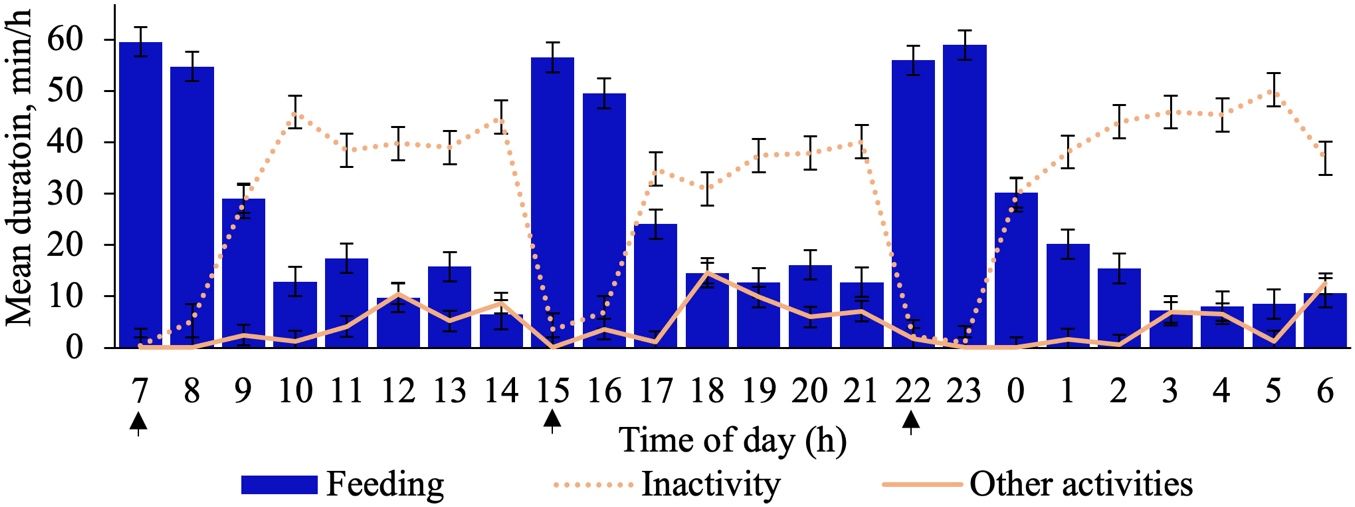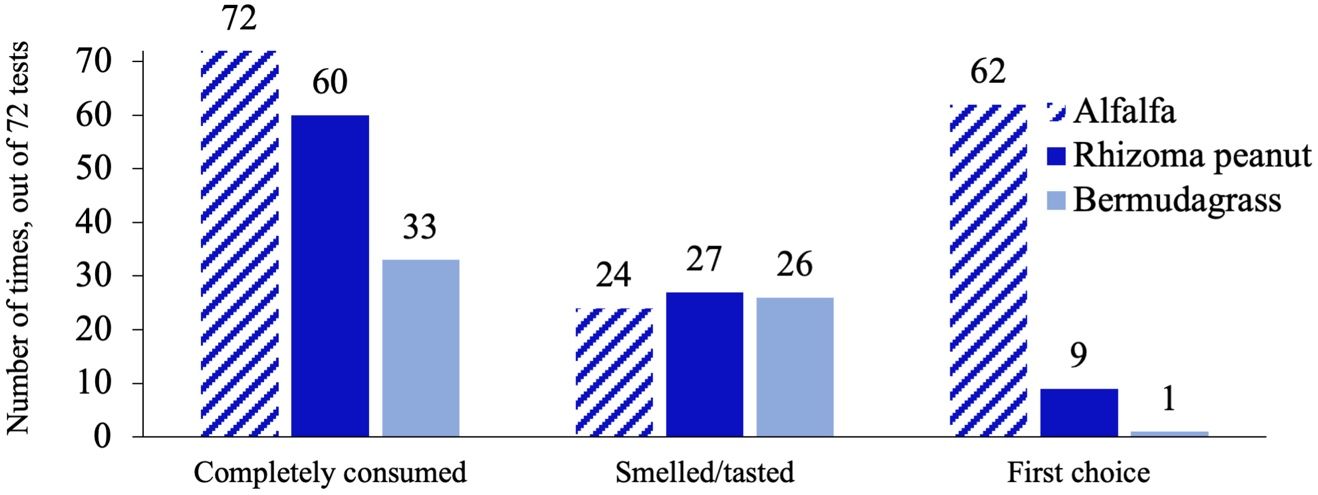Introduction
This Extension publication is intended to provide information to Extension agents, horse owners, and equine facility managers. Forages can provide most of the required nutrients, help maintain normal gastrointestinal function, and improve the immune system of horses. The nutritional needs of maintenance horses (i.e., horses that are not growing, gestating, lactating, or exercising) can largely be met through forage-only diets. Concentrate feed should only be offered when the available forage is insufficient in quantity or quality and fails to provide adequate nutrients to support body condition and health. Consulting a horse specialist and having your pasture and/or hay analyzed for nutrient composition are essential to effective and efficient feeding management. For information on collecting forage samples for forage testing, consult a forage specialist or refer to Ask IFAS publication SS-AGR-63, "Forage Testing."
Depending on the quality of the available forage and the horse’s physiological class (e.g., growing, maintenance, or working horse), daily forage intake may range from 1.5% to 2.5% of the horse’s body weight. The lower limit of daily forage intake recommended for horses is 1.5% of body weight. Daily forage intake of 1% or lower may negatively affect their health and behavioral needs. Overall, the provision of good forage reduces or even eliminates the need for feed supplementation. In contrast, low-quality forage requires more feed supplementation or increased daily forage intake to meet the horse’s nutritional requirements. Therefore, forage quality is relative to how well that forage can meet the nutritional needs of a specific class of horse. For more information on nutritional requirements of the different classes of horses and forage crops for horses, see Ask IFAS publication SS-AGR-65, “Pastures and Forage Crops for Horses.”
Additionally, forages are also responsible for meeting the behavioral needs of horses, such as provision of adequate foraging time. Usually, high-fiber diets provide longer foraging/feeding time. In grazing conditions, horses spend at least 12 hours per day (50% of a 24-hour period) feeding to consume sufficient forage and meet their nutritional requirements. When horses are managed in stables, the feeding pattern is usually dependent on feeding management and forage type. When provided free access to hay, horses in stables tend to follow a feeding pattern similar to that of free-ranging horses (i.e., approximately 60% of the day). However, this can be reduced to as little as 20% of the day when meal feeding management is implemented with very few meals per day. Increased feeding activity occurs when meals are provided and declines as the meals are consumed. Therefore, horses should be fed several meals a day to maintain their normal feeding/foraging behavior (Figure 1). Moreover, reduced foraging activity is one of the risk factors associated with gastric ulceration and colic in horses. Diets that provide decreased feeding time commonly result in increased periods of inactivity (Figure 1) and may have negative impacts on horses (e.g., abnormal behaviors, increased anxiety and aggressive behavior, and reduced welfare).
Daily feeding time and intake are affected by the acceptability of the diet to the horse. What exactly is acceptability and why is it important? Acceptability is usually measured as preference, which is defined as a measure of relative intake of alternative forages or forage constituents. The acceptability of a forage, which is related to forage quality, dictates how well forages will be consumed. Forages with low acceptability are usually refused by the horse or result in reduced daily intake. A high-nutrient forage is of no value if it is not consumed. Therefore, selected forages for horses must meet the animals’ nutritional and behavioral needs and be well accepted.
Common Forages Used in Florida Horse Operations
In a survey of forage utilization among horse owners and equine managers in Florida, we found that the hays commonly used in horse operations are bermudagrass [Cynodon dactylon (L.) Pers], bahiagrass (Paspalum notatum Flüggé), alfalfa (Medicago sativa L.), timothy (Phleum pratense L.), orchardgrass (Dactylis glomerata L.), and rhizoma peanut (Arachis glabrata Benth.), as seen in Table 1 (Vasco et al. 2020).
Bermudagrass and bahiagrass have low to moderate nutritive value, but these warm-season grass hays are commonly fed to horses year-round. Classes of horses with higher nutritional needs are usually offered hays with moderate to high nutritive value, such as alfalfa and the cool-season grasses timothy and orchardgrass. These hays may comprise partial or total daily forage offered. Alfalfa is well known for its high nutritive value, but its acreage is limited in Florida. Alfalfa becomes more expensive than warm-season perennial grass hays used in Florida due to alfalfa’s shipping costs and increased soil fertility requirements. Rhizoma peanut has shown to be a suitable alternative to alfalfa with comparable nutritive value. Additionally, rhizoma peanut is also less expensive because it grows well in the southeastern United States. Rhizoma perennial peanut is a warm-season perennial legume well-adapted to tropical and subtropical regions. For information on establishment and management of rhizoma peanut, see Ask IFAS publication SS-AGR-421, “Strip-Planting Rhizoma Peanut into Grazing Systems.” Despite the nutritive value of rhizoma peanut, horse owners have expressed concerns regarding whether rhizoma peanut is well accepted by horses, and if its high nutritive value may result in less hay consumed, and therefore reduced foraging activity and feeding time. However, a study conducted at UF/IFAS has shown that feeding behavior is not impaired and that rhizoma peanut is well-accepted by horses (Vasco et al. 2022).

Credit: C. Vasco, J. Dubeux, E. Santos, C. Wickens, and L. Warren
Table 1. Characterization of hay utilization on horse farms in Florida (Vasco et al. 2020).
Acceptability of Rhizoma Peanut
Previous research has shown that horse preference is dependent on the nutritive value of forages, with preference positively correlated to levels of crude protein, non-structural carbohydrates, and energy, and negatively correlated to the fiber components as seen in Table 2. Due to its greater digestible energy and crude protein and lower fiber concentration compared to warm-season grasses, alfalfa is usually the most well-accepted forage. Warm-season grasses such as bermudagrass are generally less-accepted forages due to their lower digestible energy and crude protein and higher fiber concentration compared to legumes.
Table 2. Association between the forage nutrients and acceptability by horses.
In a study conducted at UF/IFAS, we found that the intermediate nutritive value of rhizoma peanut hay resulted in intermediate acceptability between alfalfa and bermudagrass (Figure 2) (Vasco et al. 2022). In this study, horse preference was tested in a set of three-choice preference tests, where horses were offered 1 kg of alfalfa, bermudagrass, and rhizoma peanut hays simultaneously and individually. In each test, we measured if the hays were completely consumed and if they were at least once left in favor of another hay, and we determined which hay was the first choice. First choice was defined as the first hay consumed for at least five consecutive minutes. Alfalfa was completely consumed in all 72 tests, smelled or tasted and left in favor of another hay in 24 of the tests, and was the first choice in 86% of the tests. Although rhizoma peanut was often left in favor of another hay, it was intermediate in complete consumption and in first choice status. Complete consumption and selection of bermudagrass as first choice were rare. Bermudagrass hay is the forage source most used in Florida (Vasco et al. 2020), which indicates horse owners perceive this hay to be well accepted by horses. Bermudagrass hay is less expensive and more available, which also explains its frequent use as forage for horses in Florida. Rhizoma peanut’s intermediate acceptance means that it is a well-accepted forage source by horses; it should not result in any negative impact in horse daily intake.

Credit: C. Vasco, J. Dubeux, E. Santos, C. Wickens, and L. Warren
Feeding Behavior of Horses Fed Rhizoma Peanut
Insufficient feeding duration and chewing activity have often been associated with undesirable behaviors such as wood chewing and stereotypies, such as weaving and cribbing. Diets with low nutritive value, such as high-fiber diets, are commonly associated with increased chewing activity and hence decreased abnormal behavior. The increased proportion of fiber in the diet of horses results in greater shear strength for chewing, and longer chewing and feeding time. The increased fiber concentration in warm-season grasses, such as bermudagrass, compared to legumes usually benefits the feeding behavior of horses. However, not all legumes result in reduced feeding time. In a study conducted at UF/IFAS (Table 3) (Vasco et al. 2022), decreased fiber concentration in the alfalfa and rhizoma peanut hays resulted in increased number of chews per minute when compared to bermudagrass. Rhizoma peanut (which is moderate in fiber levels) did not result in negative impacts on total feeding time in a 24-hour period and reduced the amount of time horses spent inactive when compared to alfalfa.
Table 3. Total daily durations of feeding, inactivity, and other activities and the rates of biting and chewing hay performed by horses fed alfalfa, rhizoma peanut, or bermudagrass hays (Vasco et al. 2022).
Summary
In addition to its superior nutritive value, rhizoma peanut hay has been demonstrated to benefit the horses’ feeding behavior with reduced inactive time, which can result in lower risk for abnormal behaviors in stabled horses. Furthermore, it has been shown to be well-accepted by horses. The acceptance of a “new” ingredient in their diets is pivotal for nutrient acquisition. Rhizoma peanut hay is a suitable alternative forage source for the Florida horse industry because of its acceptability to horses and provision of nutrients that exceed the nutritional needs of maintenance horses fed at 2% of their body weight.
References
Allen, E., C. C. Sheaffer, and K. L. Martinson. 2013. “Forage Nutritive Value and Preference of Cool-Season Grasses under Horse Grazing.” Agronomy Journal 105:679–684. https://doi.org/10.2134/agronj2012.0300
Catalano, D. N., C. C. Sheaffer, A. M. Grev, M. L. DeBoer, and K. L. Martinson. 2019. “Yield, Forage Nutritive Value, and Preference of Legumes under Horse Grazing.” Agronomy Journal 111:1312–1322. https://doi.org/10.2134/agronj2018.07.0442
Pain, S., and D. Revel. 2009. “Forage Quality Specifications: Identifying Predictors of Preference between Hays.” Barton, Australia: Rural Industries Research and Development Corporation.
Vasco, A. C. C. M., J. C. B. Dubeux Jr., A. M. Arias-Esquivel, L. K. Warren, and C. L. Wickens. 2022. “Feeding Behavior and Preference of Horses Fed Rhizoma Peanut Hay.” Journal of Veterinary Behavior 47:35–44. https://doi.org/10.1016/j.jveb.2021.09.011
Vasco, A. C. C. M., J. C. B. Dubeux Jr., M. O. Wallau, C. L. Wickens, and L. K. Warren. 2020. “Characterization of Forage Utilization and Pasture Management Practices on Florida Horse Operations.” Journal of Equine Veterinary Science 95:103253. https://doi.org/10.1016/j.jevs.2020.103253